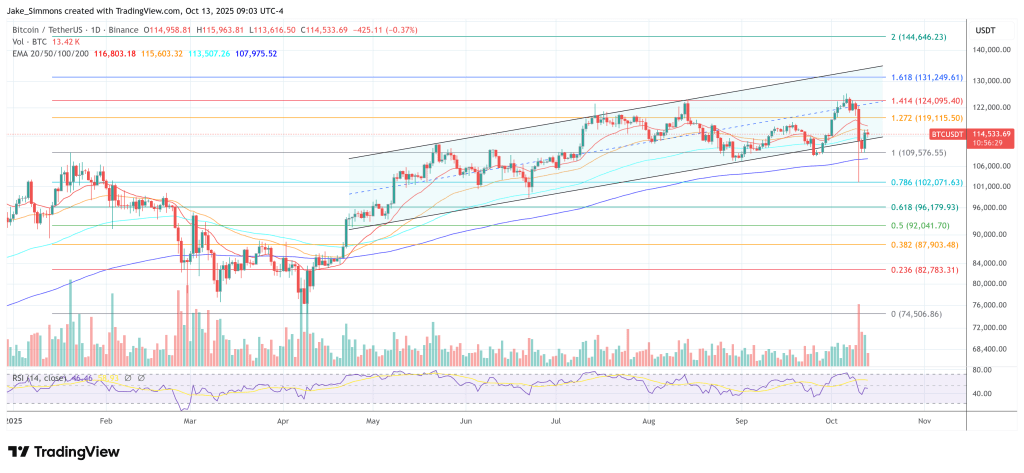
content, reviewed by leading industry experts and seasoned editors. Ad Disclosure
Changpeng “CZ” Zhao has thrust a fast-escalating on-chain mystery into the center of Bitcoin’s news cycle, amplifying an investigation that alleges a single Hyperliquid trader—long rumored to control more than 100,000 Bitcoin—both catalyzed and profited from last Friday’s violent deleveraging. “Not sure of validity. Hope someone can cross check,” CZ wrote on X as he quote-posted a 12-part thread by pseudonymous researcher Eye that attempts to tie the “Hyperliquid/Hyperunit whale” to former BitForex chief executive Garrett Jin.
Not sure of validity. Hope someone can cross check. https://t.co/SPN26EXtaw
— CZ 🔶 BNB (@cz_binance) October 12, 2025
This Is The Infamous Bitcoin Whale
The timing and profitability are not in dispute. Multiple market dashboards indicate the whale’s short bet—opened on Hyperliquid only minutes before the US–China tariff headlines hit—was closed for roughly $192 million in profit, after which a fresh ~$160 million notional Bitcoin short was reportedly opened over the weekend.
What Eye adds is a chain of attribution. The thread claims that, across August–September, the whale rotated more than $4.23 billion worth of Bitcoin into ETH on Hyperliquid using both spot and perpetuals, then funneled over 570,000 ETH into staking, ultimately interacting with a custom deposit contract.
Eye further asserts that fee funding for the address that placed the now-famous ~$735 million Bitcoin short can be traced—via a set of intermediary wallets and a Binance deposit address—to an ENS identity, “ereignis.eth,” which Eye says resolves to a second ENS, “garrettjin.eth,” and ultimately to Jin’s public X account.
In Eye’s telling, the Bitcoin provenance fans out to old withdrawals from HTX/Huobi, OKX, ViaBTC, Bixin and Binance from seven to eight years ago, a period overlapping Jin’s early-crypto resume. None of this, Eye concedes between the lines, is a signed confession; it is a linkage map built from address reuse, ENS pointers and funding paths.
Jin effectively acknowledged he is the individual in Eye’s crosshairs—while rejecting the most explosive insinuations. “Hi @cz_binance, thanks for sharing my personal and private information. To clarify, I have no connection with the Trump family or @DonaldJTrumpJr — this isn’t insider trading,” he wrote on Monday.
Hi @cz_binance, thanks for sharing my personal and private information. To clarify, I have no connection with the Trump family or @DonaldJTrumpJr — this isn’t insider trading.
— Garrett (@GarrettBullish) October 13, 2025
He followed with a multi-part explanation of the team’s bearish posture going into the move, arguing that the crash was telegraphed by a blend of macro, cross-asset correlation and structural leverage signals rather than privileged political intel.
“From a technical analysis perspective, US tech stocks, A-shares tech stocks, and major cryptocurrencies have all shown overbought signals, such as MACD divergence,” Jin posted, adding that “cryptos and US tech stocks historically have a high positive correlation,” and that his internal models had thrown “risk alerts” amid rising US–China trade frictions since late September.
He also contended that extreme retail leverage on non-cash-flowing crypto assets made a liquidity spiral inevitable, and proposed that exchanges adopting “a stabilization fund-like mechanism, similar to US equities, [to] provide liquidity support during crises” would reduce repeat blow-ups.
At press time, Bitcoin traded at $114,533.
 Bitcoin faces the EMA100, 1-day chart | Source: BTCUSDT on TradingView.com
Bitcoin faces the EMA100, 1-day chart | Source: BTCUSDT on TradingView.comFeatured image created with DALL.E, chart from TradingView.com

Editorial Process for bitcoinist is centered on delivering thoroughly researched, accurate, and unbiased content. We uphold strict sourcing standards, and each page undergoes diligent review by our team of top technology experts and seasoned editors. This process ensures the integrity, relevance, and value of our content for our readers.

.jpeg)



















.jpeg)













 English (US) ·
English (US) ·